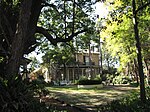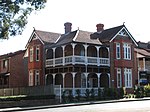St Patrick's Cemetery, North Parramatta
1824 establishments in AustraliaCemeteries established in the 1820sCemeteries in SydneyNew South Wales State Heritage RegisterNorth Parramatta, New South Wales ... and 1 more
Roman Catholic Diocese of Parramatta

St Patrick's Roman Catholic Cemetery is a heritage-listed closed cemetery on the corner of Pennant Hills Road and Church Street, North Parramatta, City of Parramatta, New South Wales, Australia. It is the earliest formalised Catholic cemetery in Australia, and was in use from 1824 to 1972. A central feature of this historic cemetery is the 1844 Gothic revival styled mortuary chapel, which is the oldest mortuary chapel in Australia. The cemetery was closed in 1972 and subsequently transferred to the City of Parramatta in 1975. It was added to the New South Wales State Heritage Register on 23 March 2012.
Excerpt from the Wikipedia article St Patrick's Cemetery, North Parramatta (License: CC BY-SA 3.0, Authors, Images).St Patrick's Cemetery, North Parramatta
Prince Street, Sydney North Parramatta
Geographical coordinates (GPS) Address Nearby Places Show on map
Geographical coordinates (GPS)
| Latitude | Longitude |
|---|---|
| N -33.796606 ° | E 151.005914 ° |
Address
Prince Street 7
2151 Sydney, North Parramatta
New South Wales, Australia
Open on Google Maps








